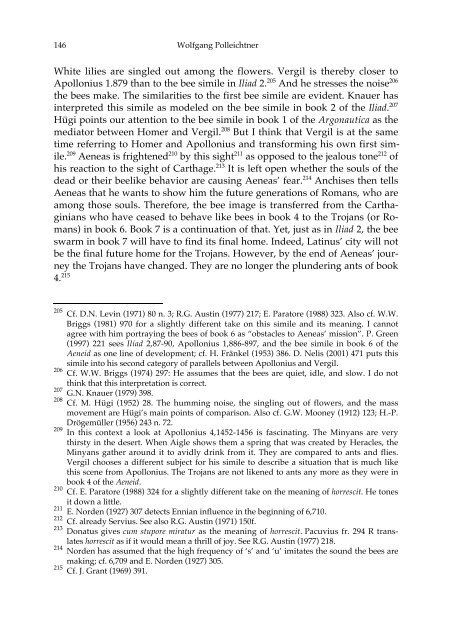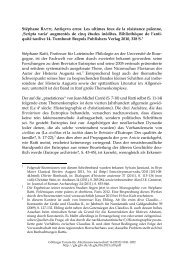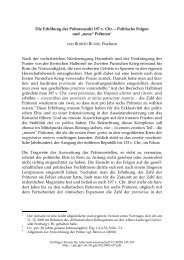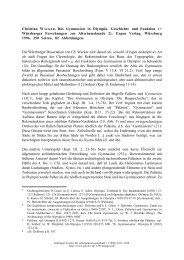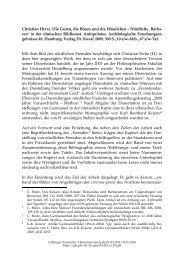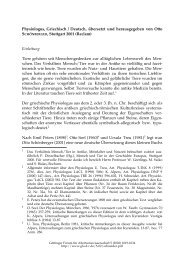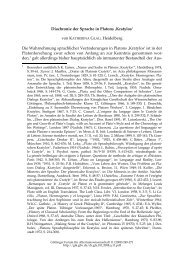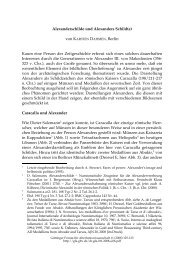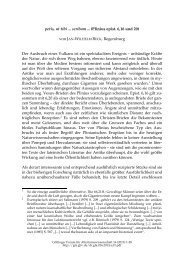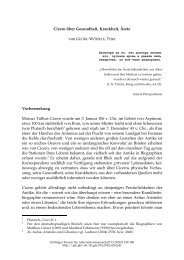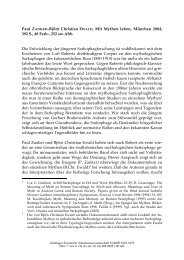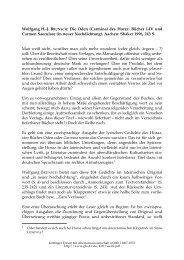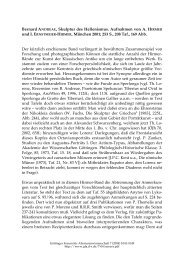The Bee Simile - Göttinger Forum für Altertumswissenschaft
The Bee Simile - Göttinger Forum für Altertumswissenschaft
The Bee Simile - Göttinger Forum für Altertumswissenschaft
Create successful ePaper yourself
Turn your PDF publications into a flip-book with our unique Google optimized e-Paper software.
146 Wolfgang Polleichtner<br />
White lilies are singled out among the flowers. Vergil is thereby closer to<br />
Apollonius 1.879 than to the bee simile in Iliad 2. 205 And he stresses the noise 206<br />
the bees make. <strong>The</strong> similarities to the first bee simile are evident. Knauer has<br />
interpreted this simile as modeled on the bee simile in book 2 of the Iliad. 207<br />
Hügi points our attention to the bee simile in book 1 of the Argonautica as the<br />
mediator between Homer and Vergil. 208 But I think that Vergil is at the same<br />
time referring to Homer and Apollonius and transforming his own first simile.<br />
209 Aeneas is frightened 210 by this sight 211 as opposed to the jealous tone 212 of<br />
his reaction to the sight of Carthage. 213 It is left open whether the souls of the<br />
dead or their beelike behavior are causing Aeneas’ fear. 214 Anchises then tells<br />
Aeneas that he wants to show him the future generations of Romans, who are<br />
among those souls. <strong>The</strong>refore, the bee image is transferred from the Carthaginians<br />
who have ceased to behave like bees in book 4 to the Trojans (or Romans)<br />
in book 6. Book 7 is a continuation of that. Yet, just as in Iliad 2, the bee<br />
swarm in book 7 will have to find its final home. Indeed, Latinus’ city will not<br />
be the final future home for the Trojans. However, by the end of Aeneas’ journey<br />
the Trojans have changed. <strong>The</strong>y are no longer the plundering ants of book<br />
4. 215<br />
205 Cf. D.N. Levin (1971) 80 n. 3; R.G. Austin (1977) 217; E. Paratore (1988) 323. Also cf. W.W.<br />
Briggs (1981) 970 for a slightly different take on this simile and its meaning. I cannot<br />
agree with him portraying the bees of book 6 as “obstacles to Aeneas’ mission”. P. Green<br />
(1997) 221 sees Iliad 2,87-90, Apollonius 1,886-897, and the bee simile in book 6 of the<br />
Aeneid as one line of development; cf. H. Fränkel (1953) 386. D. Nelis (2001) 471 puts this<br />
simile into his second category of parallels between Apollonius and Vergil.<br />
206 Cf. W.W. Briggs (1974) 297: He assumes that the bees are quiet, idle, and slow. I do not<br />
think that this interpretation is correct.<br />
207 G.N. Knauer (1979) 398.<br />
208 Cf. M. Hügi (1952) 28. <strong>The</strong> humming noise, the singling out of flowers, and the mass<br />
movement are Hügi’s main points of comparison. Also cf. G.W. Mooney (1912) 123; H.-P.<br />
Drögemüller (1956) 243 n. 72.<br />
209 In this context a look at Apollonius 4,1452-1456 is fascinating. <strong>The</strong> Minyans are very<br />
thirsty in the desert. When Aigle shows them a spring that was created by Heracles, the<br />
Minyans gather around it to avidly drink from it. <strong>The</strong>y are compared to ants and flies.<br />
Vergil chooses a different subject for his simile to describe a situation that is much like<br />
this scene from Apollonius. <strong>The</strong> Trojans are not likened to ants any more as they were in<br />
book 4 of the Aeneid.<br />
210 Cf. E. Paratore (1988) 324 for a slightly different take on the meaning of horrescit. He tones<br />
it down a little.<br />
211 E. Norden (1927) 307 detects Ennian influence in the beginning of 6,710.<br />
212 Cf. already Servius. See also R.G. Austin (1971) 150f.<br />
213 Donatus gives cum stupore miratur as the meaning of horrescit. Pacuvius fr. 294 R translates<br />
horrescit as if it would mean a thrill of joy. See R.G. Austin (1977) 218.<br />
214 Norden has assumed that the high frequency of ‘s’ and ‘u’ imitates the sound the bees are<br />
making; cf. 6,709 and E. Norden (1927) 305.<br />
215 Cf. J. Grant (1969) 391.


